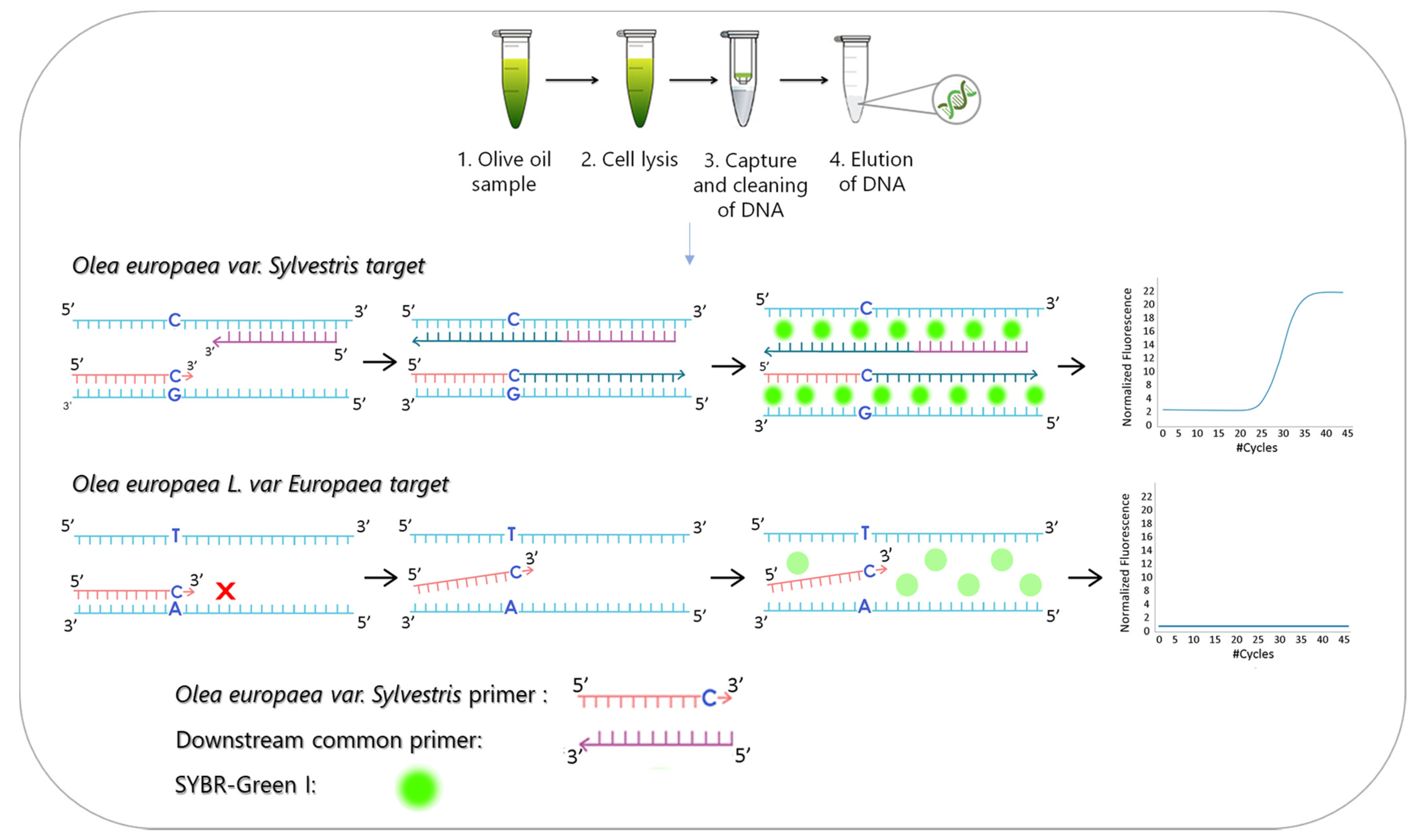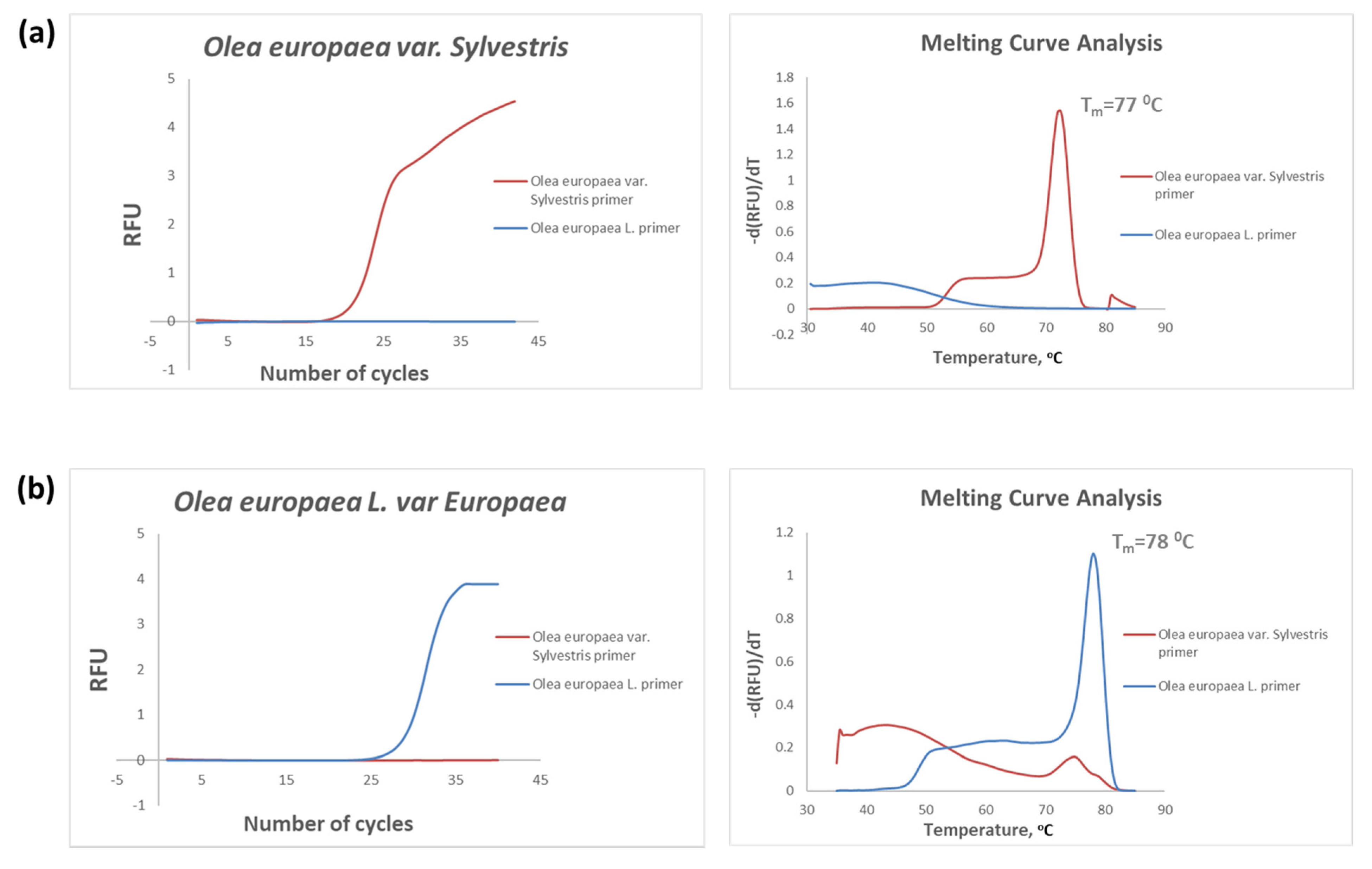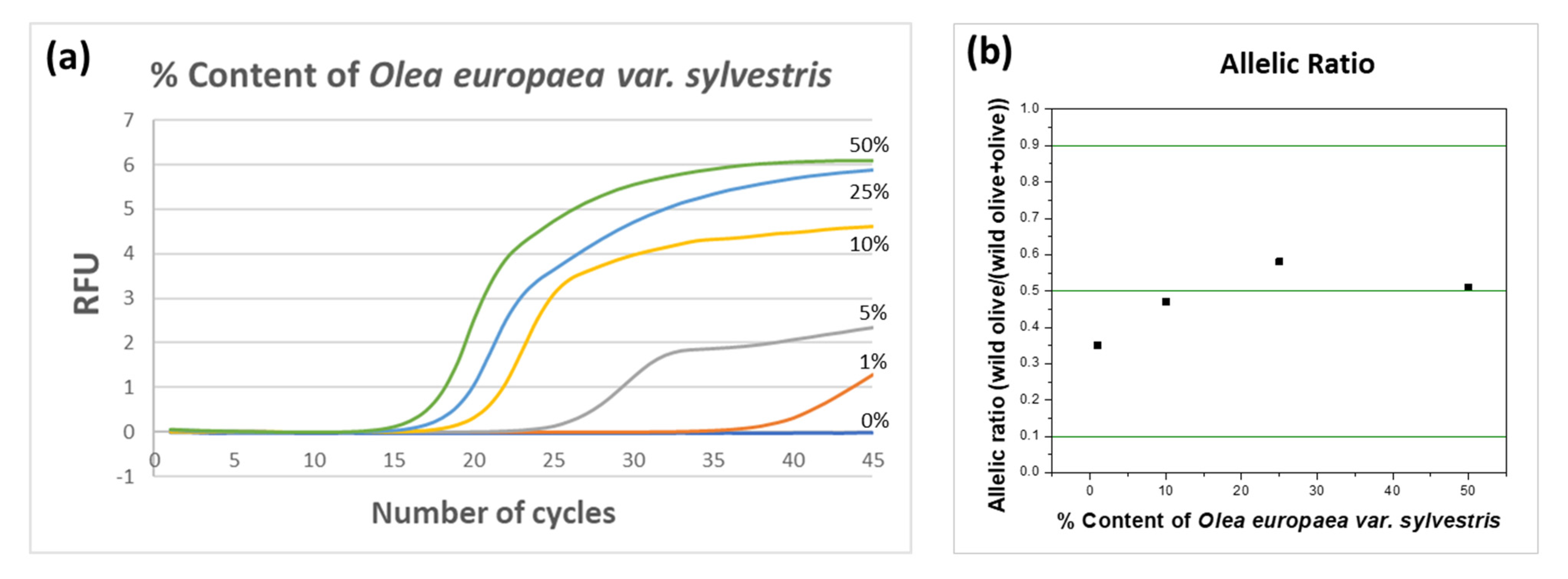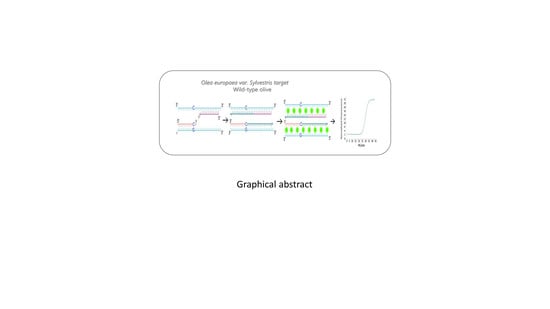Genetic Identification of the Wild Form of Olive (Olea europaea var. sylvestris) Using Allele-Specific Real-Time PCR
Abstract
1. Introduction
2. Materials and Methods
2.1. Materials and Instrumentation
2.2. DNA Isolation Procedure
2.3. Design of the Primers
2.4. Allele-Specific, Real-Time PCR
3. Results and Discussion
3.1. DNA Isolation
3.2. Optimization of the PCR Conditions
3.3. Specificity of the Allele-Specific Primers
3.4. Detectability of the Method in Binary DNA Mixtures
3.5. Reproducibility of the Method
4. Conclusions
Author Contributions
Funding
Acknowledgments
Conflicts of Interest
References
- Kassa, A.; Konrad, H.; Geburek, T. Molecular diversity and gene flow within and among different subspecies of the wild olive (Olea europaea L.): A review. Flora Morphol. Distrib. Funct. Ecol. Plants 2019, 250, 18–26. [Google Scholar] [CrossRef]
- Bouarroudj, K.; Tamendjari, A.; Larbat, R. Quality, composition and antioxidant activity of Algerian wild olive (Olea europaea L. subsp. Oleaster) oil. Ind. Crops Prod. 2016, 83, 484–491. [Google Scholar] [CrossRef]
- Beghé, D.; Piotti, A.; Satovic, Z.; De La Rosa, R.; Belaj, A. Pollen-mediated gene flow and fine-scale spatial genetic structure in Olea europaea subsp. Europaea var. sylvestris. Ann. Bot. 2017, 119, 671–679. [Google Scholar] [PubMed]
- Bracci, T.; Busconi, M.; Fogher, C.; Sebastiani, L. Molecular studies in olive (Olea europaea L.): Overview on DNA markers applications and recent advances in genome analysis. Plant Cell Rep. 2011, 30, 449–462. [Google Scholar] [CrossRef] [PubMed]
- Angiolillo, A.; Mencuccini, M.; Baldoni, L. Olive genetic diversity assessed using amplified fragment length polymorphisms. Theor. Appl. Genet. 1999, 98, 411–421. [Google Scholar] [CrossRef]
- Baldoni, L.; Tosti, N.; Ricciolini, C.; Belaj, A.; Arcioni, S.; Pannelli, G.; Germana, M.A.; Mulas, M.; Porceddu, A. Genetic structure of wild and cultivated olives in the central Mediterranean Basin. Ann. Bot. 2006, 98, 935–942. [Google Scholar] [CrossRef]
- Bronzini de Caraffa, V.; Maury, J.; Gambotti, C.; Breton, C.; Bervillé, A.; Giannettini, J. Mitochondrial DNA variation and RAPD mark oleasters, olive and feral olive from Western and Eastern Mediterranean. Theor. Appl. Genet. 2002, 104, 1209–1216. [Google Scholar] [CrossRef]
- Sesli, M.; Yeǧenoǧlu, E.D. Determination of the genetic relationships between wild olive (Olea europaea oleaster) varieties grown in the Aegean Region. Genet. Mol. Res. 2010, 9, 884–890. [Google Scholar] [CrossRef]
- Besnard, G.; Khadari, B.; Baradat, P.; Bervillé, A. Combination of chloroplast and mitochondrial DNA polymorphisms to study cytoplasm genetic differentiation in the olive complex (Olea europaea L.). Theor. Appl. Genet. 2002, 105, 139–144. [Google Scholar] [CrossRef]
- Besnard, G.; Bervillé, A. Multiple origins for Mediterranean olive (Olea europaea L. ssp. europaea) based upon mitochondrial DNA polymorphisms. Comptes Rendus l’Académie des Sci. Ser. III Sci. Vie 2000, 323, 173–181. [Google Scholar] [CrossRef]
- Vargas, P.; Kadereit, J.W. Molecular fingerprinting evidence (ISSR, inter-simple sequence repeats) for a wild status of Olea europaea L. (Oleaceae) in the Eurosiberian North of the Iberian Peninsula. Flora 2001, 196, 142–152. [Google Scholar] [CrossRef]
- Breton, C.; Tersac, M.; Bervillé, A. Genetic diversity and gene flow between the wild olive (oleaster, Olea europaea L.) and the olive: Several Plio-Pleistocene refuge zones in the Mediterranean Basin suggested by simple sequence repeats analysis. J. Biogeogr. 2006, 33, 1916–1928. [Google Scholar] [CrossRef]
- Belaj, A.; León, L.; Satovic, Z.; De la Rosa, R. Variability of wild olives (Olea europaea subsp. europaea var. sylvestris) analyzed by agro-morphological traits and SSR markers. Sci. Hortic. 2011, 129, 561–569. [Google Scholar] [CrossRef]
- Belaj, A.; Muñoz-Diez, C.; Baldoni, L.; Porceddu, A.; Barranco, D.; Satovic, Z. Genetic diversity and population structure of wild olives from the north-western Mediterranean assessed by SSR markers. Ann. Bot. 2007, 100, 449–458. [Google Scholar] [CrossRef] [PubMed]
- Abood, A.A.; Al-Ansari, A.M.; Migdadi, H.M.; Okla, M.K.; Assaeed, A.M.; Hegazy, A.K.; Alshameri, A.M.; Khan, M.A. Molecular and phytochemical analysis of wild type and olive cultivars grown under Saudi Arabian environment. 3 Biotech 2017, 7, 289. [Google Scholar] [CrossRef] [PubMed]
- Chiappetta, A.; Muto, A.; Muzzalupo, R.; Muzzalupo, I. New rapid procedure for genetic characterization of Italian wild olive (Olea europaea) and traceability of virgin olive oils by means of SSR markers. Sci. Hortic. 2017, 226, 42–49. [Google Scholar] [CrossRef]
- Loureiro, J.; Rodriguez, E.; Costa, A.; Santos, C. Nuclear DNA content estimations in wild olive (Olea europaea L. ssp. europaea var. sylvestris Brot.) and Portuguese cultivars of O. europaea using flow cytometry. Genet. Resour. Crop Evol. 2007, 54, 21–25. [Google Scholar] [CrossRef]
- Brito, G.; Loureiro, J.; Lopes, T.; Rodriguez, E.; Santos, C. Genetic characterisation of olive trees from Madeira Archipelago using flow cytometry and microsatellite markers. Genet. Resour. Crop Evol. 2008, 55, 657–664. [Google Scholar] [CrossRef]
- Paudel, S.; Magrati, T.; Lamichhane, J.R.; Centre, C.H. Antimicrobial activity of wild olive crude extracts in vitro. Int. J. Pharma Sci. Res. 2011, 2, 110–113. [Google Scholar]
- Colombo, M.L. Botanicals authentication in food, food supplements and herbal medicinal products. Plant Biosyst. 2016, 150, 22–26. [Google Scholar] [CrossRef]
- Lafka, T.-I.; Lazou, A.; Sinanoglou, V.; Lazos, E. Phenolic extracts from wild olive leaves and their potential as edible oils antioxidants. Foods 2013, 2, 18–31. [Google Scholar] [CrossRef] [PubMed]
- Mohamed, R.; Pineda, M.; Aguilar, M. Antioxidant capacity of extracts from wild and crop plants of the Mediterranean region. J. Food Sci. 2007, 72, S059–S063. [Google Scholar] [CrossRef]
- Unver, T.; Wu, Z.; Sterck, L.; Turktas, M.; Lohaus, R.; Li, Z.; Yang, M.; He, L.; Deng, T.; Escalante, F.J.; et al. Genome of wild olive and the evolution of oil biosynthesis. Proc. Natl. Acad. Sci. USA 2017, 114, E9413–E9422. [Google Scholar] [CrossRef] [PubMed]
- Kalogianni, D.P.; Bazakos, C.; Boutsika, L.M.; Targem, M.B.; Christopoulos, T.K.; Kalaitzis, P.; Ioannou, P.C. Olive oil DNA fingerprinting by multiplex SNP genotyping on fluorescent microspheres. J. Agric. Food Chem. 2015, 63, 3121–3128. [Google Scholar] [CrossRef] [PubMed]
- Bazakos, C.; Dulger, A.O.; Uncu, A.T.; Spaniolas, S.; Spano, T.; Kalaitzis, P. A SNP-based PCR−RFLP capillary electrophoresis analysis for the identification of the varietal origin of olive oils. Food Chem. 2012, 134, 2411–2418. [Google Scholar] [CrossRef]
- Agrielaio-olea Sylvestris. Available online: https://www.agrielaio.gr/wild-olive-oil.php (accessed on 8 April 2020).
- Montemurro, C.; Pasqualone, A.; Rosanna Simeone, R.; Sabetta, W.; Blanco, A. AFLP molecular markers to identify virgin olive oils from single Italian cultivars. Eur. Food Res. Technol. 2008, 226, 1439–1444. [Google Scholar] [CrossRef]
- Lo, Y.T.; Shaw, P.C. DNA-based techniques for authentication of processed food and food supplements. Food Chem. 2018, 240, 767–774. [Google Scholar] [CrossRef]
- Costa, J.; Amaral, J.S.; Fernandes, T.J.R.; Batista, A.; Oliveira, M.B.P.P.; Mafra, I. DNA extraction from plant food supplements: Influence of different pharmaceutical excipients. Mol. Cell. Probes 2015, 29, 473–478. [Google Scholar] [CrossRef]
- Kim, Y.S.; Yu, H.K.; Lee, B.Z.; Hong, K.W. Effect of DNA extraction methods on the detection of porcine ingredients in halal cosmetics using real-time PCR. Appl. Biol. Chem. 2018, 61, 549–555. [Google Scholar] [CrossRef]
- Zabidi, A.R.; Fauzi, F.N.; Abd Razak, F.N.; Rosli, D.; Jamil, M.Z.M.; Wan Ibrahim, W.K.; Yahaya, N. Screening porcine DNA in collagen cream cosmetic products. Food Res. 2020, 4, 151–156. [Google Scholar] [CrossRef]



| Primer Name | 5′–3′ Oligonucleotide Sequence | Melting Temperature * |
|---|---|---|
| Olea europaea var Sylvestris upstream primer | TGTCAATTTTAATCACTACTGC | 62 °C |
| Olea europaea L. Europaea upstream primer | TGTCAATTTTAATCACTACTGT | 61 °C |
| Common downstream primer | CTAGTAACTAATCCTAACATGGAA | 64 °C |
© 2020 by the authors. Licensee MDPI, Basel, Switzerland. This article is an open access article distributed under the terms and conditions of the Creative Commons Attribution (CC BY) license (http://creativecommons.org/licenses/by/4.0/).
Share and Cite
Kyriakopoulou, C.I.; Kalogianni, D.P. Genetic Identification of the Wild Form of Olive (Olea europaea var. sylvestris) Using Allele-Specific Real-Time PCR. Foods 2020, 9, 467. https://doi.org/10.3390/foods9040467
Kyriakopoulou CI, Kalogianni DP. Genetic Identification of the Wild Form of Olive (Olea europaea var. sylvestris) Using Allele-Specific Real-Time PCR. Foods. 2020; 9(4):467. https://doi.org/10.3390/foods9040467
Chicago/Turabian StyleKyriakopoulou, Christina I., and Despina P. Kalogianni. 2020. "Genetic Identification of the Wild Form of Olive (Olea europaea var. sylvestris) Using Allele-Specific Real-Time PCR" Foods 9, no. 4: 467. https://doi.org/10.3390/foods9040467
APA StyleKyriakopoulou, C. I., & Kalogianni, D. P. (2020). Genetic Identification of the Wild Form of Olive (Olea europaea var. sylvestris) Using Allele-Specific Real-Time PCR. Foods, 9(4), 467. https://doi.org/10.3390/foods9040467







